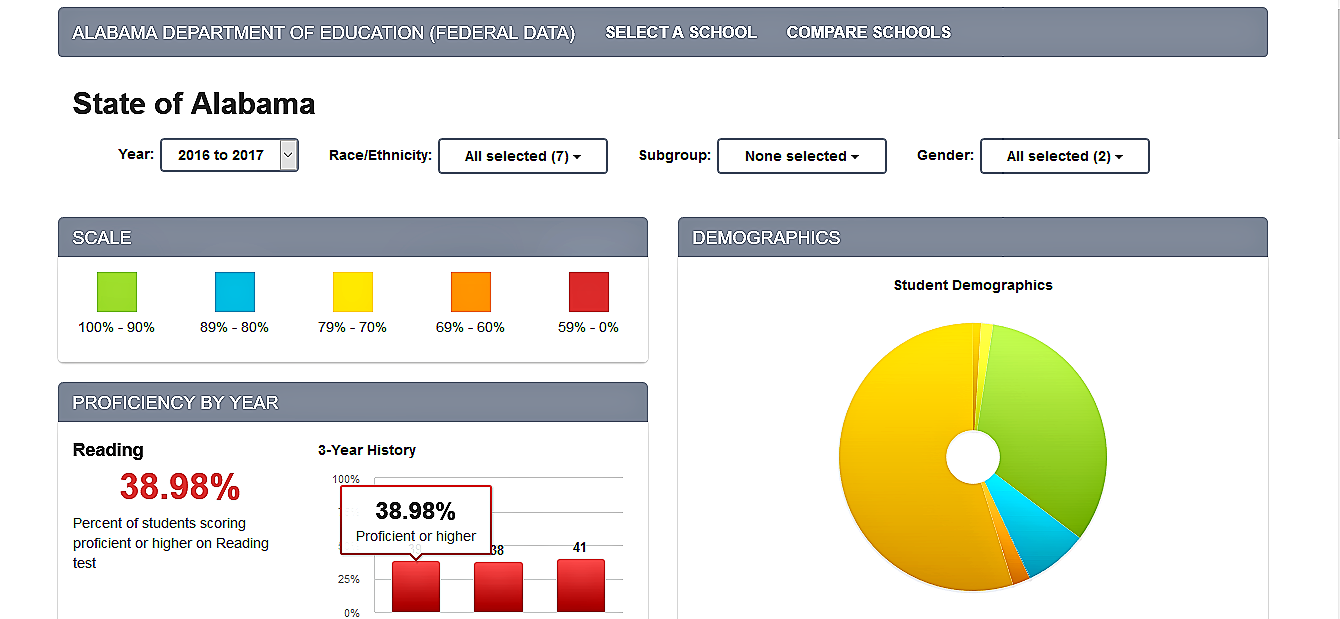The Alabama State Department of Education published its new online dashboard system on Dec. 30, 2017. For now, the system includes only partial “report card” data and partial ACT Aspire results. The state “report card” will be released on Feb. 1, 2018. / Alabama State Department of Education
CULLMAN – The Alabama State Department of Education (ASDE) recently published its new online dashboard system. The system, for now, shows federal data for public schools, statewide, and enables users to see information from individual schools and school systems and to compare that data between schools. It also contains ACT Aspire test scores, on which the “Proficiency by Year” percentage scores are based. Some of those scores have been published by a local website, according to Cullman County Schools Superintendent Shane Barnette, and have been taken by readers to be the annual state “report card” promised by the ASDE through the Alabama Accountability System (AAS). This is not the case. State report card data will not be released until Feb. 1; however, ASDE officials said the state report card data will be also be shared, when released, through the public dashboard system.
The AAS’ official purpose statement reads:
"Alabama ACT No. 2012-402, requires the State Superintendent of Education to develop a school grading system reflective of school and district performance. Alabama's goal is to provide another transparent layer of accountability as it relates to Elementary and Secondary education in the State.
“This law requires the state to use state-authorized assessments and other key performance indicators that give a total profile of the school or school system, or both, a school’s grade, at a minimum shall be based on a combination of student achievement scores, achievement gap, college and career readiness, learning gains, and other indicators as determined by the State Superintendent of Education to impact student learning and success."
Last year’s state report card scores (see www.cullmantribune.com/articles/2017/01/03/state-releases-f-report-card-2015-2016-wide-range-results-throughout-cullman and www.cullmantribune.com/articles/2017/01/19/county-schools-superintendent-shane-barnette-addresses-state-dept-education) were based on several factors:
- Learning Gains (for schools that have no grade 12) – Determined based on individual students who demonstrate improvement in reading/math from one year to the next using multiple years of data.
- Student Achievement- Determined based on the percentage of proficient students in the area of reading/math utilizing assessments in tested grades.
- Graduation Rate (for schools that have grade 12) – Determined based on the percentage of high school students who graduate within 4 or 5 years of first entering the 9th grade.
- Local Indicators- Created by individual schools, approved by the ALSDE and required to be tied to student outcomes.
So, taking all of that into consideration, readers should be aware that the data, as it exists today in the dashboard, is not yet complete. The scores included in the preliminary report represent, according to Barnette, only a portion of a larger document that will be the actual state "report card" scheduled for public release on Feb. 1.
About the ACT Aspire test
The proficiency scores in the report are based on ACT Aspire scores from tests administered as follows:
- reading proficiency, grades 3-8, 10
- mathematics, grades 3-8, 10
- science, grades 5, 7, 10
- Not all grades take the test, and in some cases, not all grades listed may be tested. The results, then, do not represent the total performance of a school or system, but more of a snapshot taken at a certain point in the process.
State contract canceled
It should be noted that the 2016-17 school year was the last in which the ACT Aspire assessment was planned to be used. For years, Alabama students across the board scored lower than expected on the test, and lower on average than they did on the previous state assessment, leading to concerns that Aspire might not be properly aligned with Alabama’s curriculum content. After the results of the spring 2017 Aspire test returned to Alabama by ACT were found to contain bad data, the ASDE voted to cancel its contract with ACT for the Aspire. The state will continue to use the 11th grade college readiness assessment and 12th grade work readiness assessment from ACT.
The numbers
Compared to last year’s profiles, the Aspire scores only represent the “Student Achievement” score. They do not account for daily classroom performance or other school activities, and graduation rates and college/career readiness scores were not readily available. By comparing 2017 to the two previous years (included in the dashboard chart), though, some idea may be gained about learning gains. The scores are percentile rankings out of 100, and represent the percentage of students who performed at or above their grade-level standards. Higher scores are better.
County schools
Reading Proficiency – 41.21
Mathematics – 44.76
Science – 35.13
Learning Gains: From 2015-17, the system showed generally consistent performance in Reading and Science, but a steady gain in Mathematics scores.
City schools
Reading Proficiency – 59.41
Mathematics – 70.58
Science – 59.08
Learning Gains: From 2015-17, the system showed a small but steady drop in Reading scores, while scoring gains in both Mathematics and Science.
Overall Alabama public school averages
Reading Proficiency – 38.98
Mathematics – 43.64
Science – 34.72
Learning Gains: The state showed slightly lower Reading scores in 2017 than in 2015, with small but steady gains in both Mathematics and Science across the three-year span.
Cullman City Schools’ scores are significantly higher than both the state average and the scores from Cullman County Schools. Even the lower scores of the county schools were still slightly above the state average.
County Superintendent Shane Barnette responds
The Tribune spoke with Barnette, who issued the following statement:
“Some media outlets have published scores stating that they were our system’s State Report Card, while in all actuality they represent a small portion of the overall State Report Card. The scores that were reported represent one grade, on one test, which the state has since stopped using due to it being considered flawed. While we will own our scores and work to improve in that area, the State Report Card doesn’t actually come out until Feb. 1. I am extremely proud of the teachers and students in our school system. Our educators work hard every day to help all of our students to be successful.”
Separately, the superintendent added: “Yes, those scores do represent a need for improvement in that area, and we have been working hard to address those needs. The actual State Report Card pulls data from multiple grade levels and different components. I would love to address the report when it is released.”
Statistics
Certain statistics about schools and systems are also available on the ASDE dashboard.
In the Cullman County school system:
- 62.4 percent of students qualify for free or reduced meals. Economically disadvantaged students in the county system averaged seven to eight points below the system average on the Aspire.
- 13.9 percent of students have physical or mental disabilities. The county system has both a larger number and a larger percentage of special needs students than the city system. Special needs students in the county system averaged 30 to 36 points below the system average on the Aspire.
- 53.5 percent of teachers/staff have master’s degrees
- 6.1 percent of teachers/staff have post-graduate credentials
In the Cullman City school system:
- 32.1 percent of students qualify for free or reduced meals. Economically disadvantaged students in the city system averaged 14 to 15 points below the system average on the Aspire.
- 8.0 percent of students have physical or mental disabilities. Special needs students in the city system averaged 33 to 44 points below the system average on the Aspire.
- 52.7 percent of teachers/staff have master’s degrees
- 4.9 percent of teachers/staff have post-graduate credentials
Find the dashboard online at http://qrne.ws/dashboard.
Look for a full report from The Tribune on the statewide report card data when it is released on Feb. 1.
Copyright 2018 Humble Roots, LLC. All Rights Reserved.



























